Effect of Secondary Combustion on Thrust Regulation of Gas Generator Cycle Rocket Engine
Abstract
:1. Introduction
2. Gas Generator Design
3. Computational Modeling and Simulation
3.1. Flow Separation Analysis
3.2. Secondary Injection Analysis
3.2.1. Configuration C1 and C2: Effect of Temperature
3.2.2. Configuration C1 and C2: Effect of Mach Number
3.2.3. Configuration C3 and C4: Effect of Temperature
3.2.4. Configuration C3 and C4: Effect of Mach Number
4. Experimental Setup
4.1. Experiment Boundary Conditions
4.2. Experimental Test Results and Discussion
4.2.1. Primary Combustion Chamber Pressure “Pc”
4.2.2. Nozzle Temperature Profile with Secondary Injection
4.2.3. Nozzle Pressure Profile with Secondary Injection
4.2.4. Experimental Test Results Validation with CFD
4.2.5. Instrumentation Error and Calibration
4.2.6. Experimental and CFD Simulation Percentage Error
5. Chemical Equilibrium
5.1. Gibbs Free Energy
Mass Balance Constraints
5.2. Method of Steepest Descent
5.2.1. Setup Problem
- Set T and P of the problem.
- Set the species involved by setting the formula coefficient matrix, β.
- Set initial composition. Calculate the number of moles of each element and set the vector, b.
5.2.2. Initial Guess, X
5.2.3. Compute ∇f(X)
5.2.4. Determine α
- Find the maximum of the derivatives computed.
- Fix the maximum allowable step in the variables.
- If maxF > maxStep, fix α = maxStep/maxF. Otherwise, take α = 1.
5.2.5. Check for Convergence
6. Combustion Species
7. Performance Evaluation
8. Conclusions
Author Contributions
Funding
Institutional Review Board Statement
Informed Consent Statement
Data Availability Statement
Conflicts of Interest
References
- De Almeida, D.S.; Maria, C.; Pagliuco, D.M. Development Status of L75: A Brazilian Liquid Propellant Rocket Engine. J. Aerosp. Technol. Manag. 2014, 6, 475–484. [Google Scholar] [CrossRef] [Green Version]
- Citarella, R.; Ferraiuolo, M.; Perrella, M. Thermostructural Numerical Analysis of the Thrust Chamber of a Liquid Propellant Rocket Engine. Materials 2022, 15, 5427. [Google Scholar] [CrossRef]
- Bulman, M.J. Rocket vehicle thrust augmentation within divergent section of nozzle. U.S. Patent US6568171B2, 5 July 2002. [Google Scholar]
- Borowski, S.; Dudzinski, L.; McGuire, M. Vehicle and Mission Design Options for the Human Exploration of Mars/Phobos Using Bimodal NTR and LANTR Propulsion. In Proceedings of the AIAA, Cleveland, OH, USA, 13–15 July 1998. [Google Scholar]
- Shen, J.; Yu, Y.; Liu, X.; Cao, J. Experimental Research on Microwave Ignition and Combustion Characteristics of ADN-Based Liquid Propellant. Micromachines 2022, 13, 510. [Google Scholar] [CrossRef] [PubMed]
- Li, J.; Liu, K.; Gao, Y.; Liu, S.; Wang, W.; Liu, Y. Combustion Characteristics Experimental Study of Solid Hydrocarbon Propellant for Air-Turbo Rocket. J. Propuls. Power 2018, 34, 1198–1205. [Google Scholar] [CrossRef]
- Shynkarenko, O.; Gontijo, M. Development of a Thrust Control System for Rocket Engines. In Proceedings of the Conference: 71st International Astronautical Congress (IAC 2020), Online, 12–14 October 2020. [Google Scholar]
- Liquid Propellant Gas Generators; NASA Space Vehicle Design Criteria (Chemical), NASA SP-8081; NASA Lewis Research Center: Cleveland, OH, USA, 1972; p. 110.
- Cha, J. A Study on Thrust Control System Design for Multi-Nozzle Solid Propulsion System. Master’s Thesis, Department of Aerospace and Mechanical Engineering, Korea Aerospace University, Goyang, Korea, 2014. [Google Scholar]
- Mohammed, S.; Badi, M. Static Testing Of Hybrid Rocket Engine Using Biomass College of Engineering. 2022. Available online: https://scholarworks.uaeu.ac.ae/all_theses/930 (accessed on 15 August 2022).
- Lee, D.; Lee, C. Secondary combustion in a staged hybrid rocket engine. J. Mech. Sci. Technol. 2017, 31, 3067–3073. [Google Scholar] [CrossRef]
- Marshall, J.H. Thrust Augmented Nozzle for a Hybrid Rocket with a Helical Fuel Port. Ph.D. Thesis, Utah State University, Logan, UT, USA, 2018. [Google Scholar]
- Sutton, G.P. Rocket Propulsion Elements, 7th ed.; Wiley: Hoboken, NJ, USA, 2000; ISBN 0471326429. [Google Scholar]
- Pouransari, Z. Fundamental Studies of Non-Premixed Combustion in Turbulent Wall Jets Using Direct Numerical Simulation. Doctoral Dissertation, KTH Royal Institute of Technology, Stockholm, Sweden, 2011. [Google Scholar]
- Ponomarenko, A. RPA—Tool for Rocket Propulsion Analysis. 2014. Available online: http://www.rocket-propulsion.info/resources/software/rpa/RPA_LiquidRocketEngineAnalysis.pdf (accessed on 10 September 2022).
- Ponomarenko, A. Estimation of Engine Mass. 2015, pp. 1–10. Available online: http://w.lpre.de/downloads/2/docs/RPA_EstimationOfEngineMass.pdf (accessed on 10 September 2022).
- Ponomarenko, A. Assessment of Delivered Performance of Thrust Chamber. 2013. Available online: http://w.lpre.de/downloads/2/docs/RPA_AssessmentOfDeliveredPerformance.pdf (accessed on 9 September 2022).
- Kalt, S.; Badal, D.L. Conical rocket nozzle performance under flow- separated conditions. J. Spacecr. Rocket. 1965, 2, 447–449. [Google Scholar] [CrossRef]
- Stark, R. Flow Separation in Rocket Nozzles, a Simple Criteria. In Proceedings of the 41st AIAA/ASME/SAE/ASEE Joint Propulsion Conference & Exhibit, Tucson, AZ, USA, 10–13 July 2005. [Google Scholar] [CrossRef] [Green Version]
- Balabel, A.; Hegab, A.M.; Nasr, M.; El-Behery, S.M. Assessment of turbulence modeling for gas flow in two-dimensional convergent–divergent rocket nozzle. Appl. Math. Model. 2011, 35, 3408–3422. [Google Scholar] [CrossRef]
- Munday, D.R.; Gutmark, E.J.; Liu, J.; Kailasanath, K. Flow and Acoustic Radiation from Realistic Tactical Jet CD nozzles. In Proceedings of the 14th AIAA/CEAS Aeroacoustics Conference (29th AIAA Aeroacoustics Conference), Vancouver, BC, Canada, 5–7 May 2008. [Google Scholar]
- Gvozdeva, L.G.; Chulyunin, A.Y. Numerical study of the gas flow in nozzles and supersonic jets for different values of specific heats. J. Phys. Conf. Ser. 2015, 653, 12068. [Google Scholar] [CrossRef] [Green Version]
- Olsson, D.M.; Nelson, L.S. The Nelder-Mead Simplex Procedure for Function Minimization. Technometrics 1975, 17, 45–51. [Google Scholar] [CrossRef]
- Yang, S. Descent Method—Steepest Descent and Conjugate Gradient, towards Data Science. 2020. Available online: https://towardsdatascience.com/descent-method-steepest-descent-and-conjugate-gradient-math-explained-78601d8df3ce (accessed on 10 September 2022).
- Koretsky, M.D. Engineering and Chemical Thermodynamics, 2nd ed.; John Wiley & Sons: Hoboken, NJ, USA, 2012; ISBN 978-0-470-25961-0. [Google Scholar]
- Liu, G.R.; Quek, S.S. The Finite Element Method—A Practical Course, 2nd ed.; Butterworth-Heinemann: Oxford, UK, 2013; ISBN 0-7506-5866-5. [Google Scholar]
- Cantwell, B.J. Aircraft and Rocket Propulsion; Stanford University: Stanford, CA, USA, 2021. [Google Scholar]
- Cha, J.; de Oliveira, É.J. Performance Comparison of Control Strategies for a Variable-Thrust Solid-Propellant Rocket Motor. Aerospace 2022, 9, 325. [Google Scholar] [CrossRef]
- Pizzarelli, M. Overview and analysis of the experimentally measured throat heat transfer in liquid rocket engine thrust chambers. Acta Astronaut. 2021, 184, 46–58. [Google Scholar] [CrossRef]
- Mattingly, J.D. Elements of Propulsion: Gas Turbines and Rockets; American Institute of Aeronautics and Astronautics: Reston, VA, USA, 2006; ISBN 1563477793. [Google Scholar]
- Tarifa, M.C.; Pizzuti, L.; Bernardo, S.; Bernardo, S. Theoretical Performance Analysis of Hybrid Rocket Propellants Aiming at The Design of a Test Bench and a Propulsive. In Proceedings of the 8th European Conference for Aeronautics and Space Sciences, Madrid, Spain, 1–4 July 2019. [Google Scholar]
- Yang, V. Liquid-Propellant Rocket Engine Injector Dynamics and Combustion Processes at Supercritical Conditions; The Pennsylvania State University: State College, PA, USA, 2004. [Google Scholar]

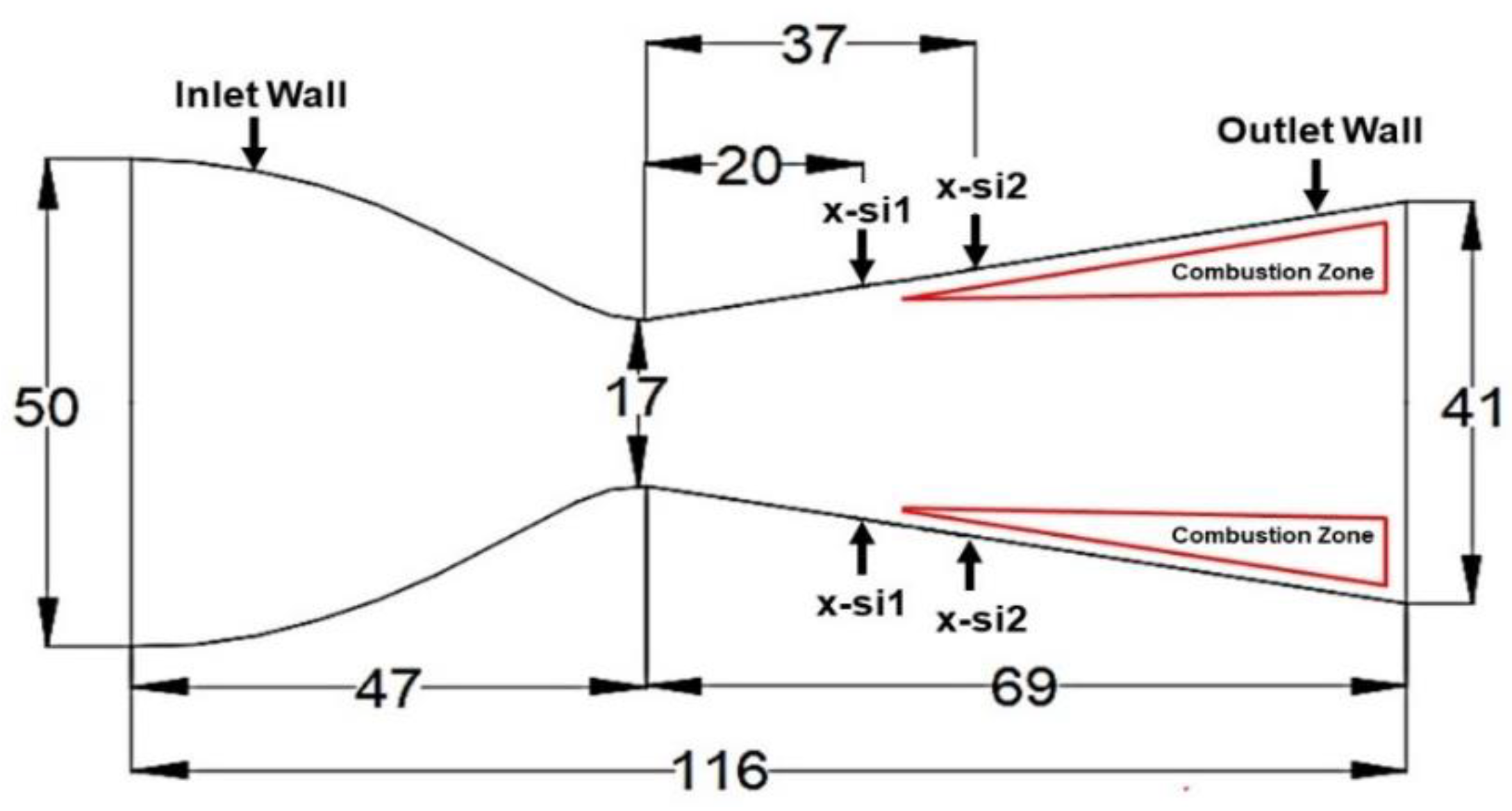




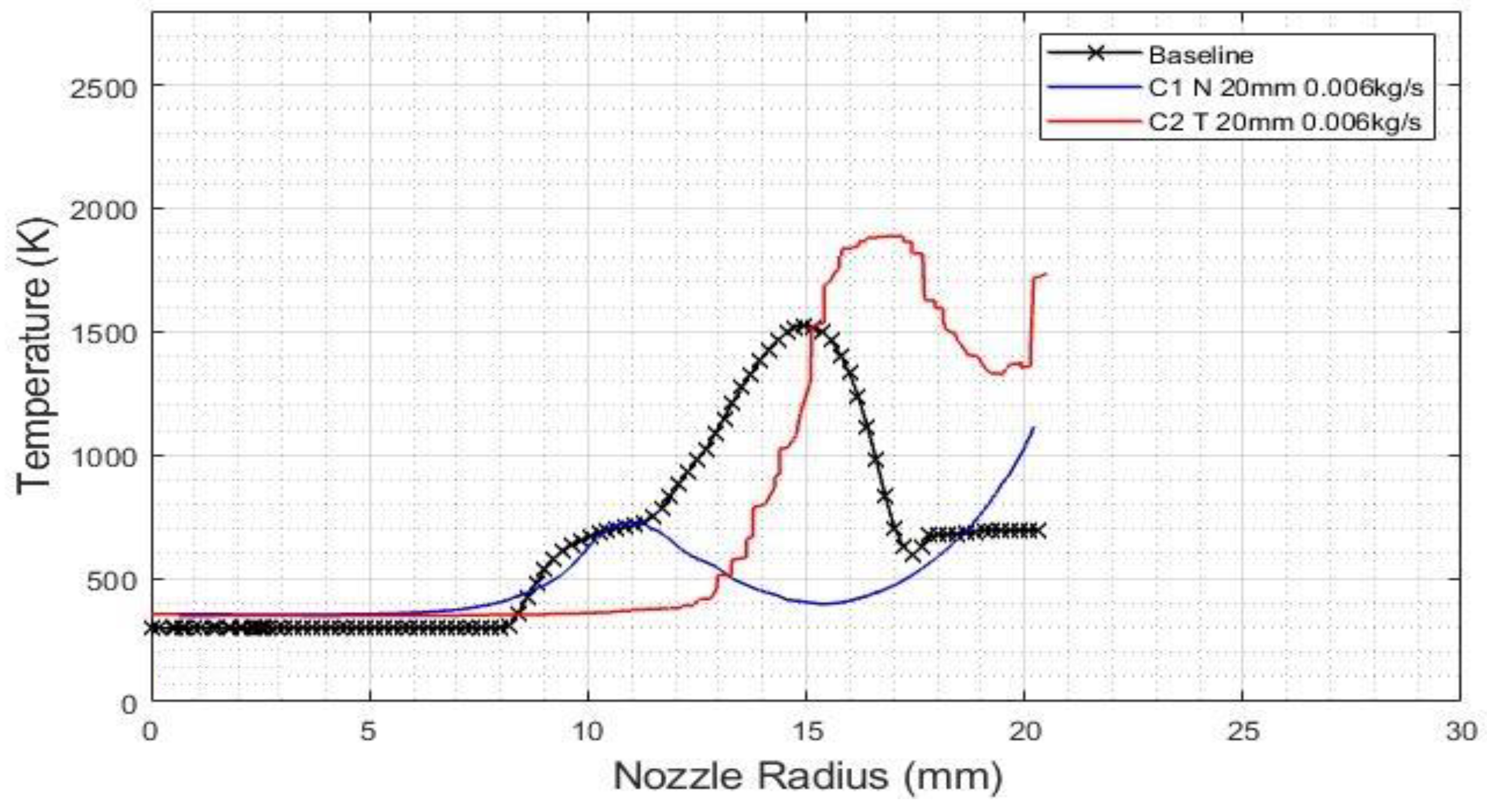


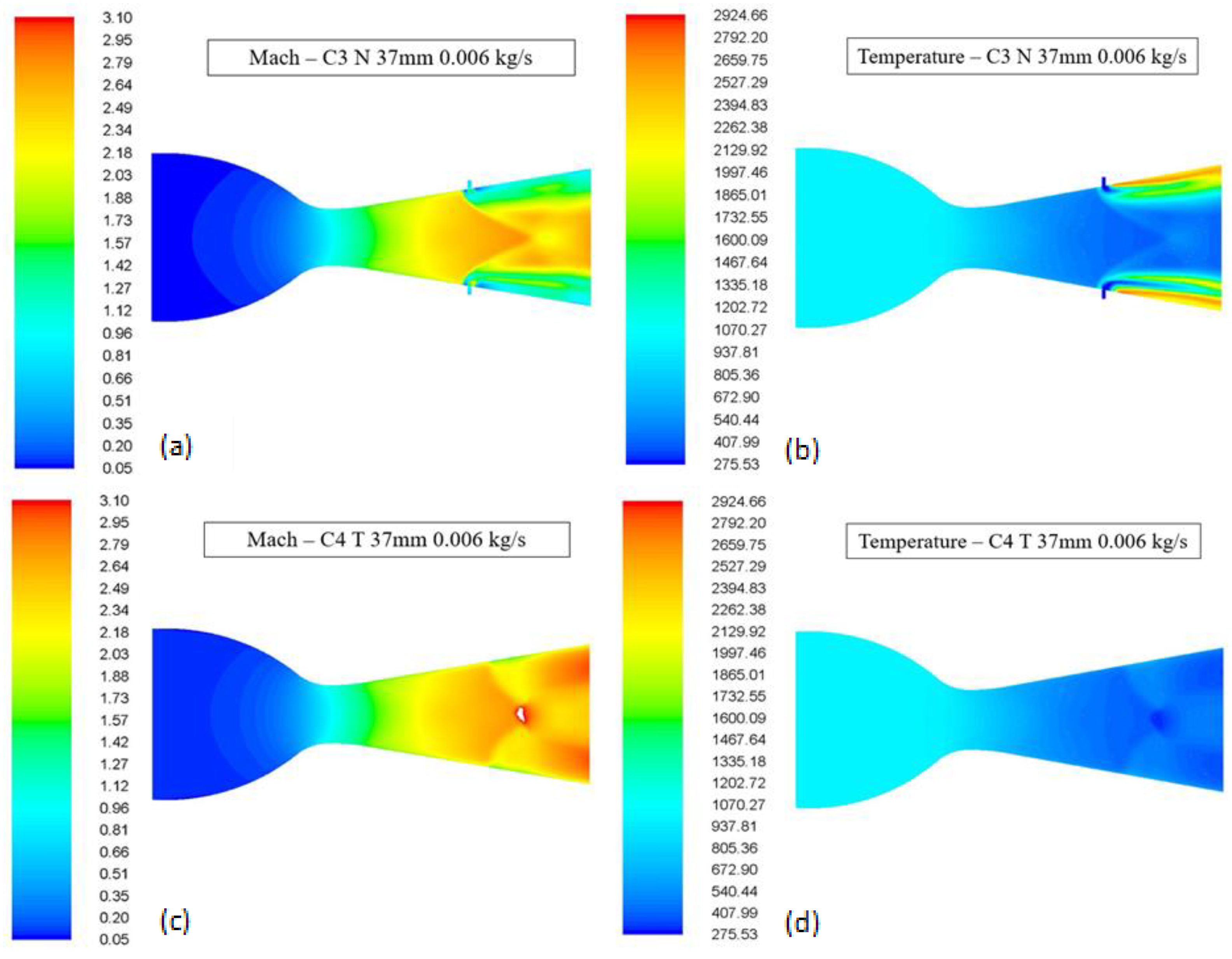


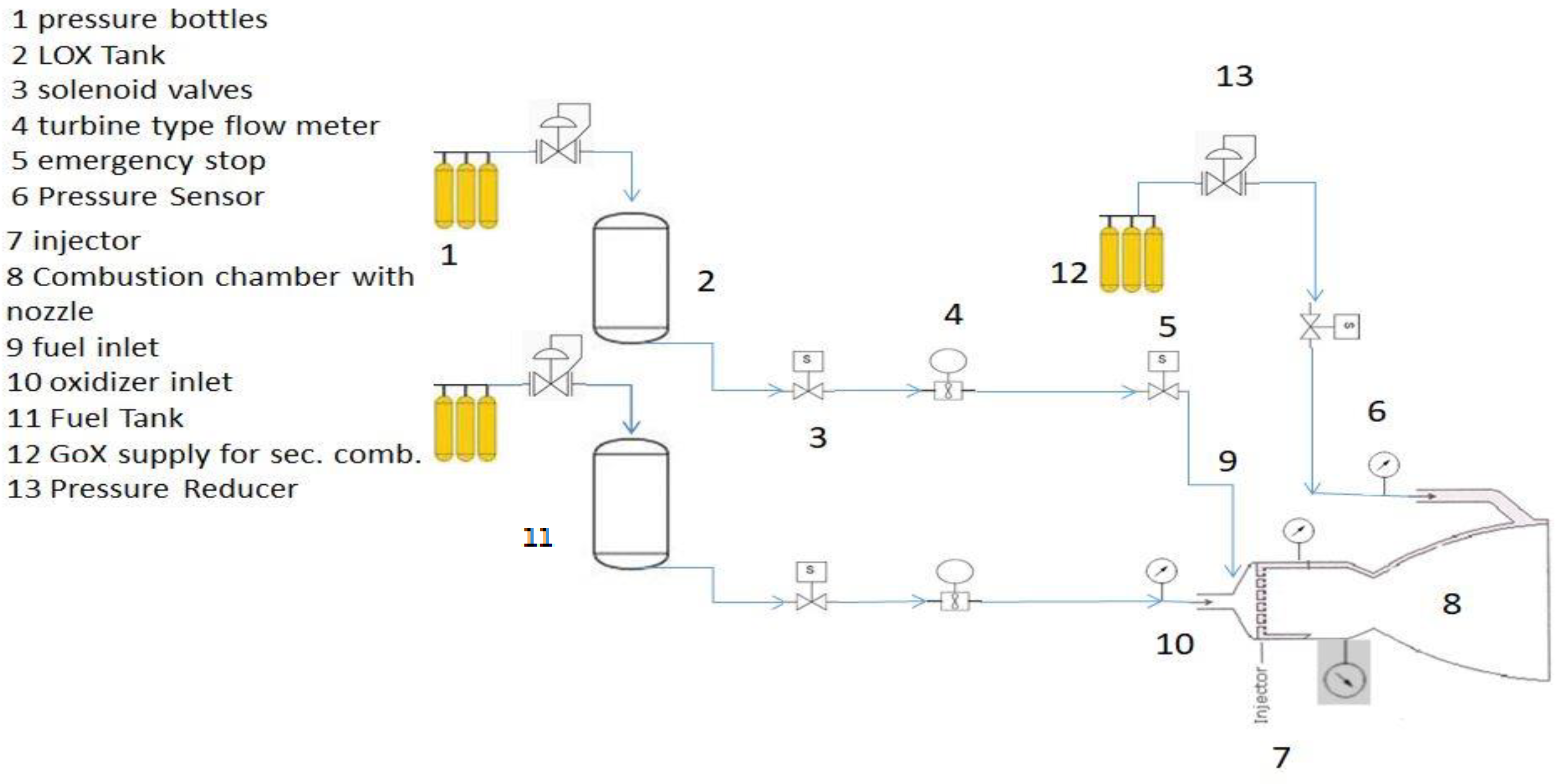




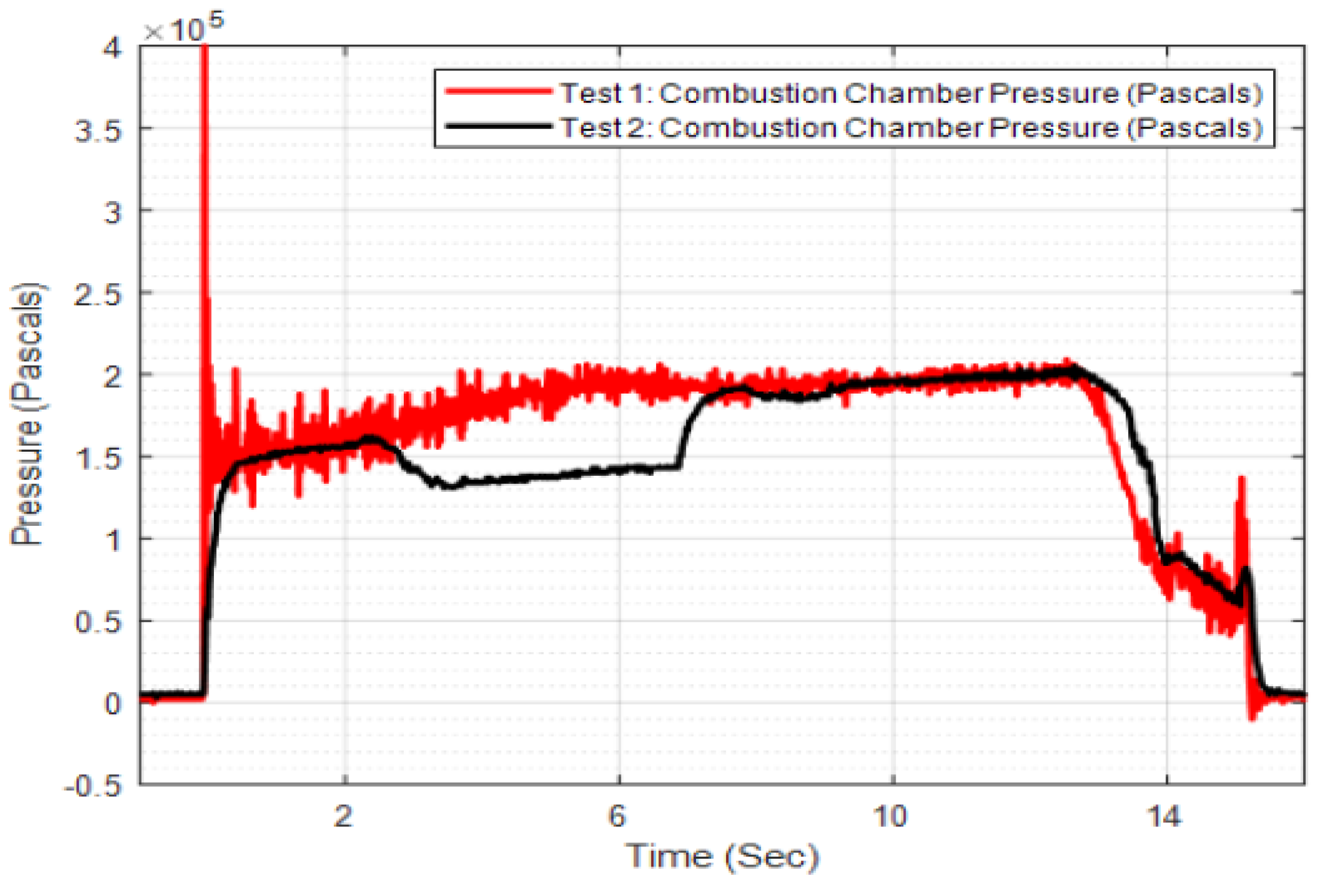
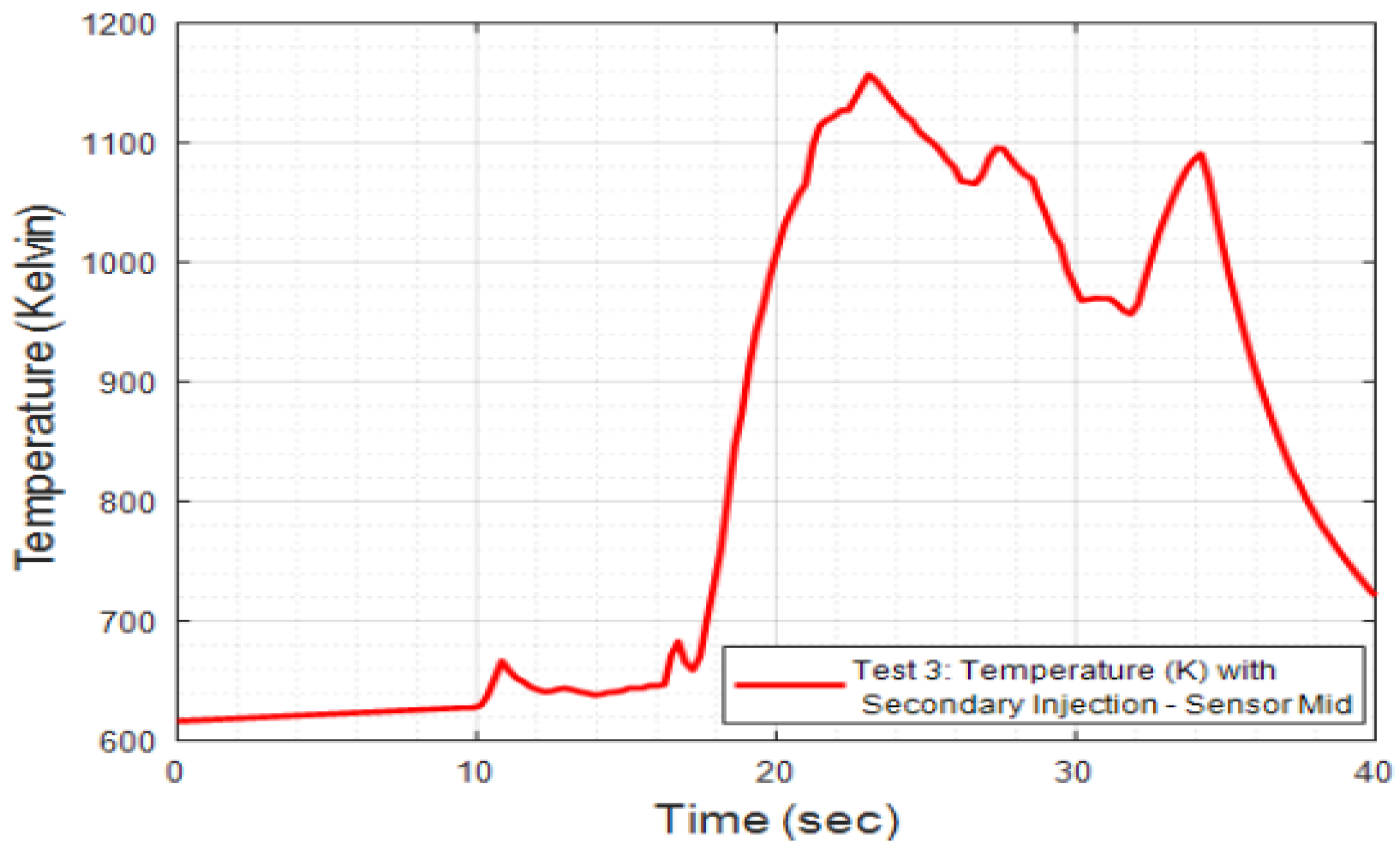
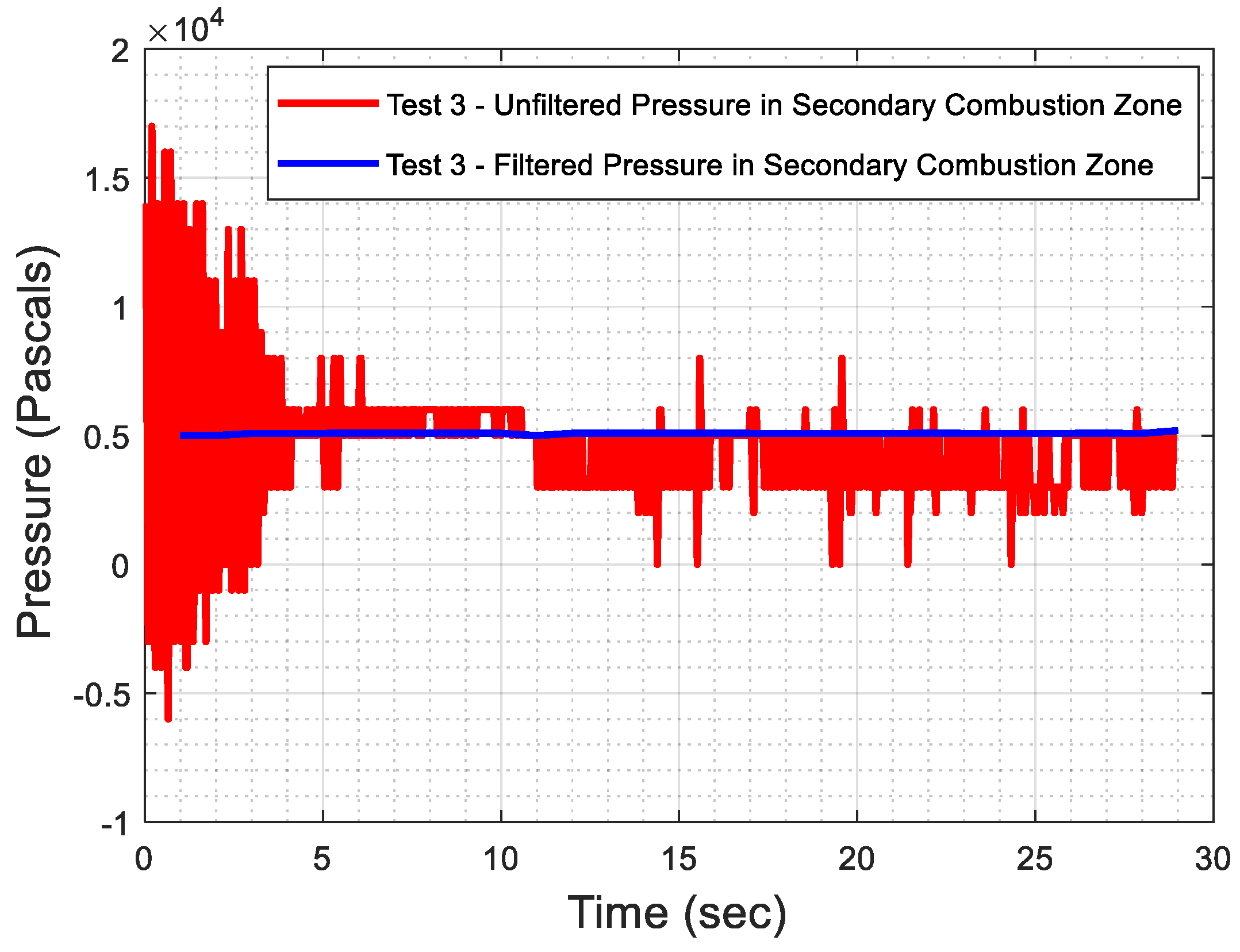

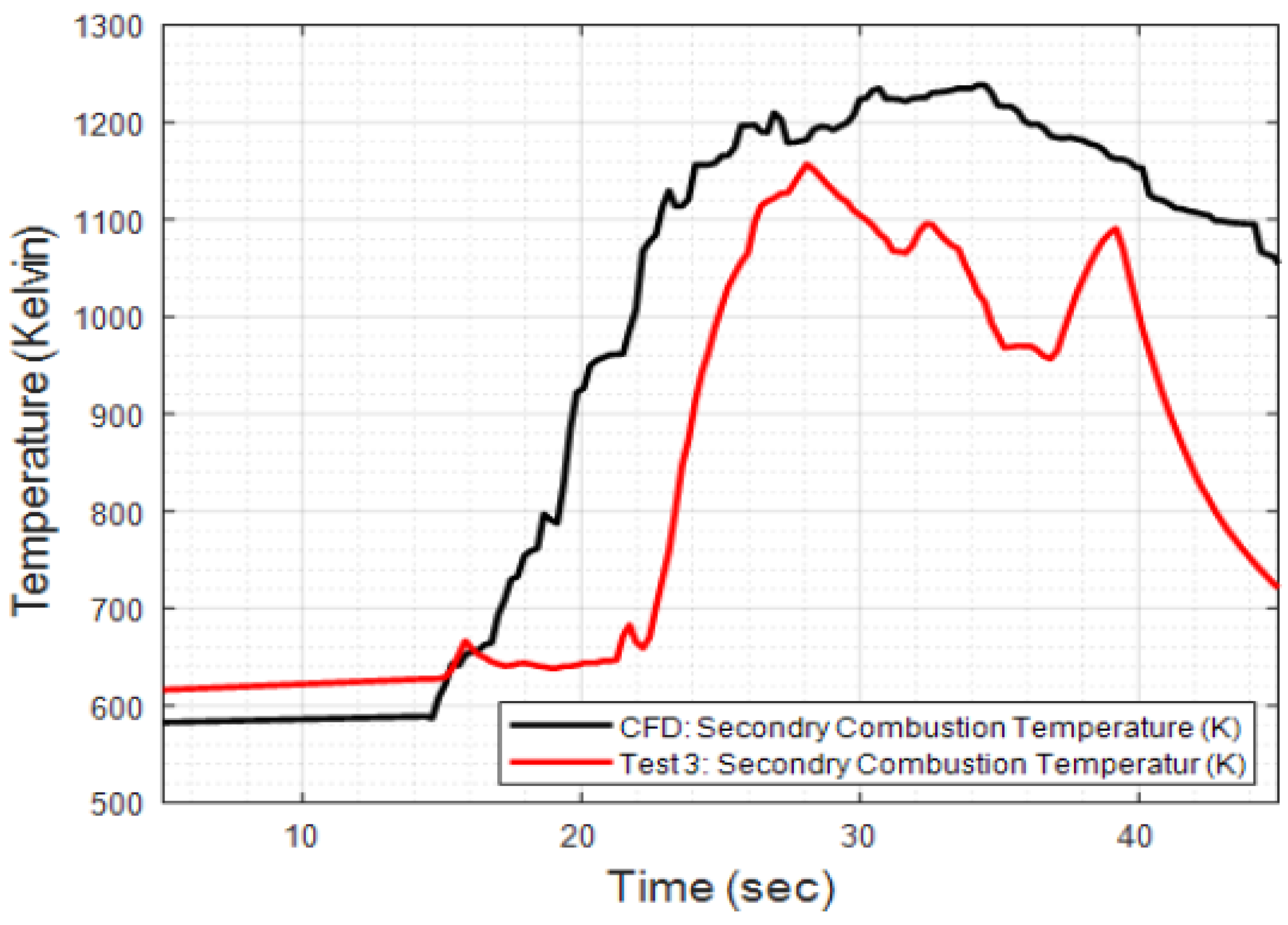


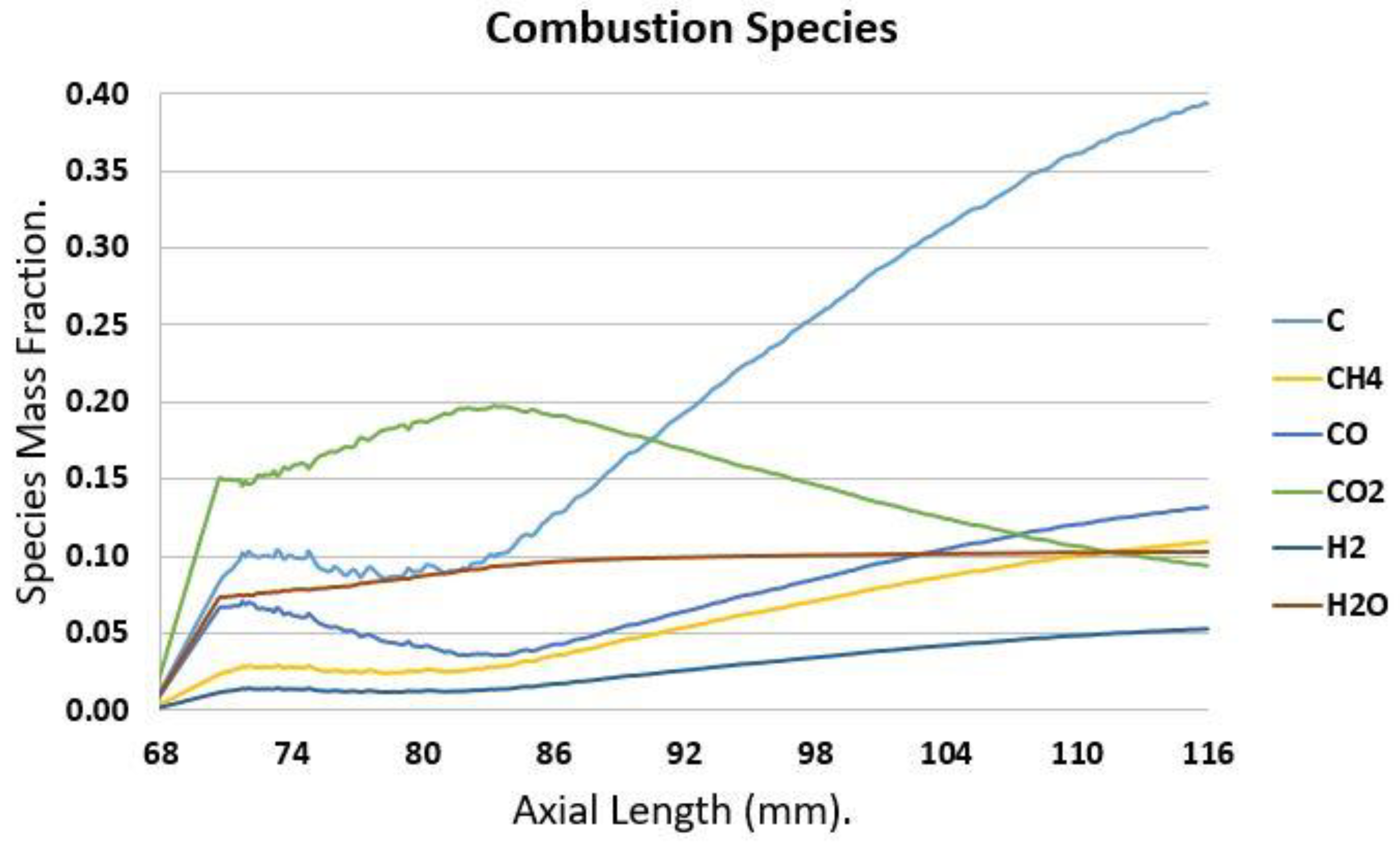

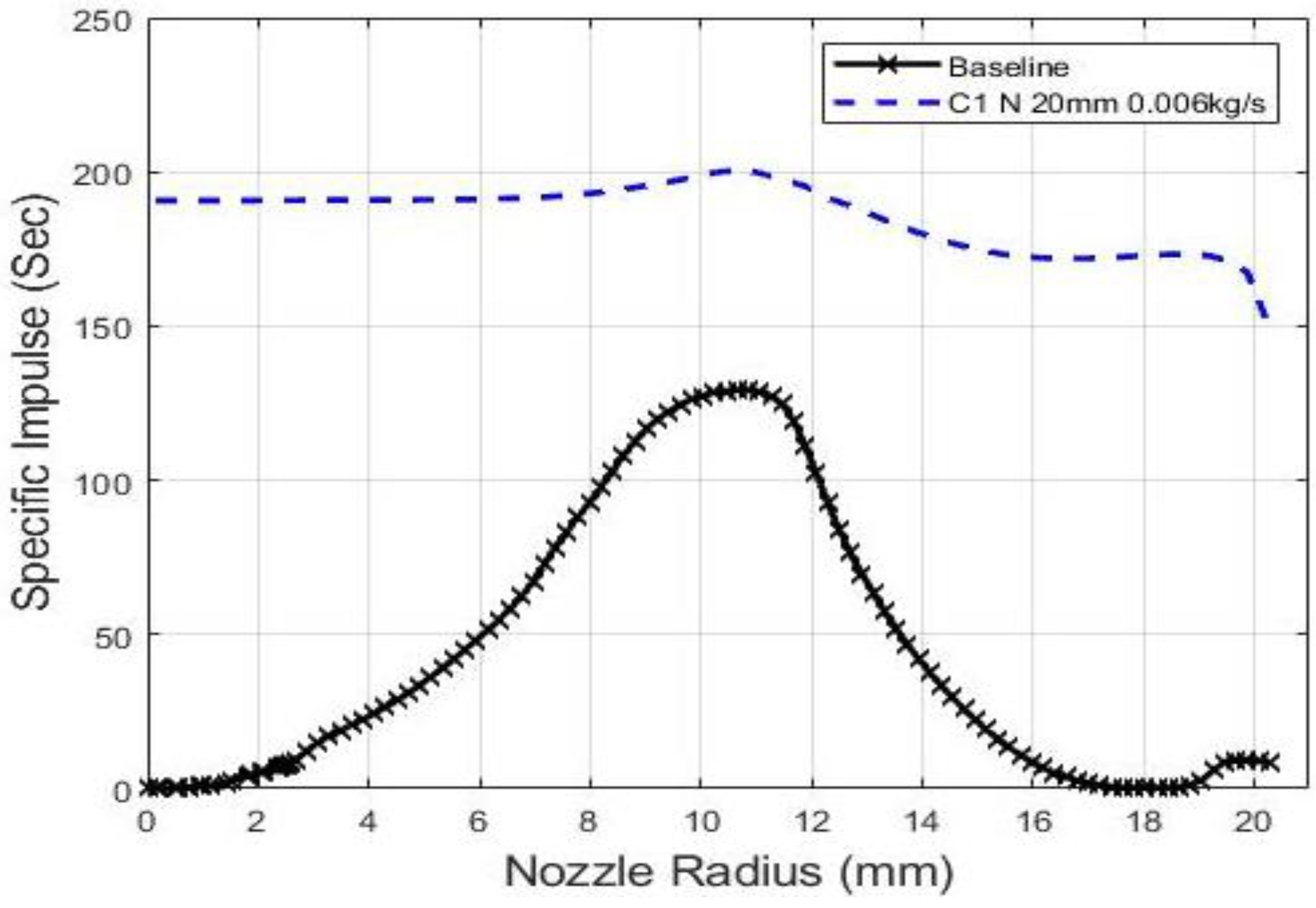
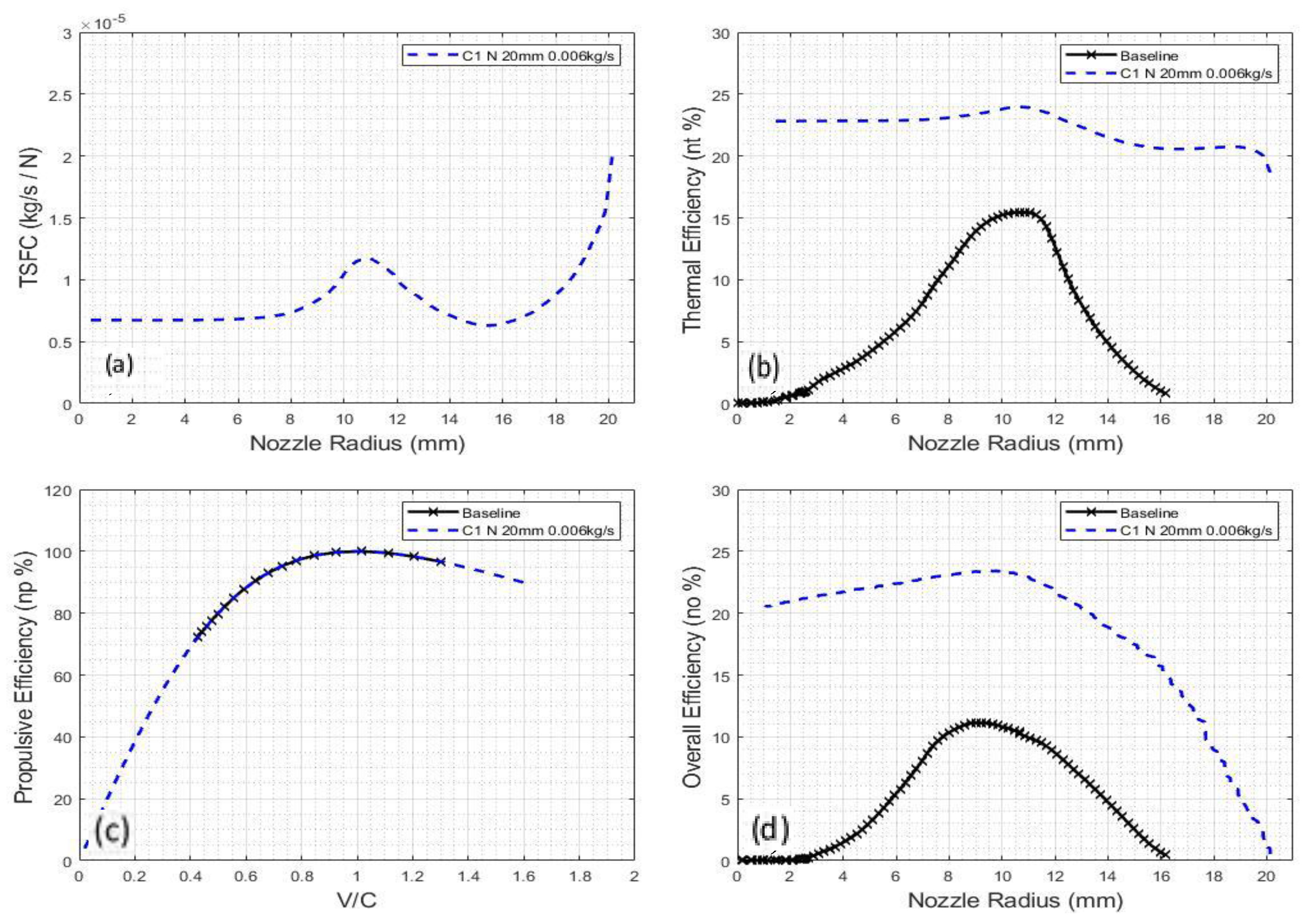
| Design Parameter | Values |
|---|---|
| Main engine propellants | LOX and RP1 |
| Oxidizer to fuel ratio | 2.2 |
| Total flow rate | 2.5 kg/s |
| Chamber pressure | 15 bar |
| Combustion temperature | 3090 K |
| Thrust | 5.5 kN |
| Design Parameter | Values |
|---|---|
| Gas generator propellants | LOX and RP1 |
| Primary combustion oxidizer to fuel ratio | 0.3 |
| Primary injection mass flow rate | 0.12 kg/s |
| Primary chamber pressure | 2 bar |
| Primary combustion temperature | 1008 K |
| Thrust | 160 N |
| Configuration Type | Secondary Injection | Injection Location | Injection Diameter |
|---|---|---|---|
| 1 | Normal | 20 mm | 1.0 mm |
| 2 | Tangent | 20 mm | 1.0 mm |
| 3 | Normal | 37 mm | 1.0 mm |
| 4 | Tangent | 37 mm | 1.0 mm |
| No. | Mesh Type | Mesh Size (Million) | Element Type |
|---|---|---|---|
| A | Coarse | 3.0 | Hexahedral |
| B | Medium | 6.0 | Hexahedral |
| C | Fine | 10.0 | Hexahedral |
| No. | Properties | Values | Units |
|---|---|---|---|
| 1 | Max thickness | 1.5 | mm |
| 2 | Number of layers | 5 | - |
| 3 | Aspect ratio | 18.0 | - |
| 4 | Max skewness ratio | 0.78 | - |
| 5 | Min orthogonal quality | 0.56 | - |
| Parameters | Value | Units |
|---|---|---|
| Nozzle inlet pressure | 2 | bar |
| Nozzle inlet temperature | 1008 | K |
| GOX injection pressure | 2 | bar |
| GOX injection temperature | 300 | K |
| GOX injection velocity | 300 | m/s |
| Nozzle outlet pressure | 0.7 | bar |
| Nozzle outlet temperature | 800 | K |
| No. | Species | Mass Fraction |
|---|---|---|
| 1 | C (gr) | 0.4768273 |
| 2 | C2H4 | 0.0000016 |
| 3 | C2H6 | 0.0000123 |
| 4 | CH4 | 0.1320777 |
| 5 | CO | 0.1579854 |
| 6 | CO2 | 0.0644395 |
| 7 | H2 | 0.0631787 |
| 8 | H2O | 0.1054770 |
| 9 | HCHO | 0.0000003 |
| Configuration Label | Injection Type | Injector Location (mm) | Mass Flow (kg/s) |
|---|---|---|---|
| C1 N 20 mm 0.006 kg/s: C1 | Normal: N | 20 | 0.006 |
| C2 T 20 mm 0.006 kg/s: C2 | Tangential: T | 20 | 0.006 |
| C3 N 37 mm 0.006 kg/s: C3 | Normal: N | 37 | 0.006 |
| C4 T 37 mm 0.006 kg/s: C4 | Tangential: T | 37 | 0.006 |
| No. | Apparatus | Details | Quantity |
|---|---|---|---|
| 1 | Pressure tanks | N2, 152 bar, 90 Liters | 2 |
| 2 | Data acquisition | Arduino 2560, ATmega2560, 6–20 V | 2 |
| 3 | Ignition mechanism | Spark Plug-Electrical Coil, 12-volts | 1 |
| 4 | Flow meter gauges | Pressure 200 bar, Temperature 366.15 K | 5 |
| 5 | Emergency stop | Kill Switch DPST-NC, 250 V, Max 338 K | 1 |
| 6 | Pressure sensors | HPT300-S, 0 to 600 bar, 308–398.15 K | 5 |
| 7 | Temperature sensors | K-Type, 73.15–1623.15 K | 5 |
| 8 | Chamber/nozzle | AISI 1018 Carbon St, Melt Temp 1093 K | 1 |
| 9 | Primary injectors | Co Axial Plate, Max Mdot 0.113 Kg/s | 1 |
| 10 | Secondary injectors | Normal, Max Dia 1 mm Each | 4 |
| 11 | Fuel tank | Kerosene, 150 bar, 20 Liters | 1 |
| 12 | First oxidizer tank | LOX, 150 bar, 82.5 Liters | 1 |
| 13 | Second oxidizer tank | GOX, 150 bar, 82.5 Liters | 1 |
| Parameters | Value | Units |
|---|---|---|
| Primary combustion pressure | 2 | bar |
| Primary combustion temperature | 1008 | K |
| Secondary injection GOX mass flow rate | 0.006 | kg/s |
| Secondary injection GOX velocity | 300 | m/s |
| No. | Species | Mass Fractions | |
|---|---|---|---|
| CFD | Chemical Equilibrium | ||
| 1 | C (gr) | 0.39412 | 0.388 |
| 2 | CH4 | 0.10917 | 0.15 |
| 3 | CO | 0.13127 | 0.12 |
| 4 | H2O | 0.10302 | 0.098 |
| 5 | CO2 | 0.0942 | 0.102 |
| 6 | H2 | 0.05223 | 0.054 |
| 7 | O2 | 0.113 | 0.099 |
Publisher’s Note: MDPI stays neutral with regard to jurisdictional claims in published maps and institutional affiliations. |
© 2022 by the authors. Licensee MDPI, Basel, Switzerland. This article is an open access article distributed under the terms and conditions of the Creative Commons Attribution (CC BY) license (https://creativecommons.org/licenses/by/4.0/).
Share and Cite
Khan, S.; Sohail, M.U.; Qamar, I.; Tariq, M.; Swati, R.F. Effect of Secondary Combustion on Thrust Regulation of Gas Generator Cycle Rocket Engine. Appl. Sci. 2022, 12, 10563. https://doi.org/10.3390/app122010563
Khan S, Sohail MU, Qamar I, Tariq M, Swati RF. Effect of Secondary Combustion on Thrust Regulation of Gas Generator Cycle Rocket Engine. Applied Sciences. 2022; 12(20):10563. https://doi.org/10.3390/app122010563
Chicago/Turabian StyleKhan, Sohaib, Muhammad Umer Sohail, Ihtzaz Qamar, Muzna Tariq, and Raees Fida Swati. 2022. "Effect of Secondary Combustion on Thrust Regulation of Gas Generator Cycle Rocket Engine" Applied Sciences 12, no. 20: 10563. https://doi.org/10.3390/app122010563
APA StyleKhan, S., Sohail, M. U., Qamar, I., Tariq, M., & Swati, R. F. (2022). Effect of Secondary Combustion on Thrust Regulation of Gas Generator Cycle Rocket Engine. Applied Sciences, 12(20), 10563. https://doi.org/10.3390/app122010563







